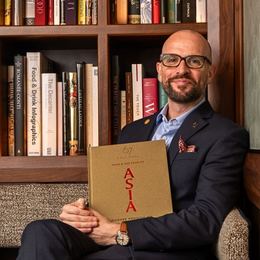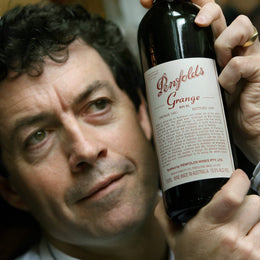For the Love of Vintage Malt, Music and Mountains: A Barside Chat with Arun Prashant at The Swan Song
"We don’t want people to see the price of an old Port Ellen or Brora and walk away disappointed. That’s unacceptable. They should have a good time at the bar even if they may not have tried the whisky they want to try. We always want to give you good memories."– Arun Prashant, co-owner and bartender at The Swan Song

The world of Scotch whisky has changed. And not everyone is happy.
“Somebody has to call them out,” said Arun Prashant, quietly but emphatically. “Somebody has to talk to these guys from Big Whisky. The stuff they’re releasing today is completely different from the stuff distilled years ago!”
“You don’t need a special palate,” the bar owner continued. “Just taste an old-style Islay whisky, say a Laphroaig distilled in the 1960s. Everyone goes ‘wow’ when they taste the burst of fruit, iodine and creaminess. Everyone can tell it’s so different from a Laphroaig distilled today.”


Arun is referring to a generation of Scotch single malts produced 50 to 60 years go – a time widely accepted as the greatest period of Scotch production. Take for example the two legendary Samaroli expressions- Laphroaig Sherry Wood 1967 and Bowmore Bouquet 1966. These bottles represent an impeccably balanced style of whisky that no longer exists- with a perfect trio of freshness, fruitiness and gentle smokiness. Unlike modern Islay expressions, you might be surprised to find that these vintage expressions aren't particularly peaty. They tend to contain bigger notes of fresh tropical fruits, accompanied by a more refined and moderate smokiness.
"People don’t realise that running a whisky bar is quite different from typical F&B concepts like a restaurant or even a cocktail bar. We’re more similar to antique trading."
– Arun Prashant
Why is whisky produced in the past so different from today? Barley is the main reason accepted by many whisky experts – including Arun himself and the guys at Dornoch Distillery. Over the years, the whisky industry has been constantly shifting to barley varieties that have higher and higher alcohol yield per pound of barley. In a bid to reduce production costs and improve efficiency, it’s possible that the spirit loses much of its taste. This is why they don’t make whisky like this anymore.
I’ve known the good folks at The Swan Song for quite some time now, but it’s been a while since we got to sit down and have a chat about life. So, on a slow Tuesday at work, I snuck out to grab a dram at The Swan Song and have a heart-to-heart conversation with Arun. While it’s usually difficult to catch the owner of an establishment in the hectic F&B industry, I knew there was no need to schedule an appointment with Arun. The Swan Song is the founders’ baby and come rain or shine, Arun is present every day that the bar is open to engage his guests.

Founded in 2017 by co-owners Arun Prashant and Kelvin Hoon, The Swan Song is one of Singapore’s best-rated whisky bars. Step into its cosy, modernist venue situated along the city state’s iconic Singapore River and you’ll find the most comprehensive collection of Scotch whiskies and friendly waitstaff trained to attend to guests of all levels in whisky knowledge, from entirely new drinkers who have no idea what is a “single malt”, to serious devotees from faraway places like Japan, making special trips to taste specific rare bottles.

However, The Swan Song’s claim to fame is based on a more poignant thing as hinted by its name. The owners are passionate about offering bottles of rare, vintage whiskies that are all but gone today. These are bottles from long-closed distilleries like Port Ellen, Brora and Lochside. There are also “legendary” bottlings of Scotch from the 60s through 80s that are living on borrowed time. Keep a brief moment of silence as you order a vintage whisky and empty the amber stuff into your glass. Because every batch of whisky is unique, chances are that you’re tasting the final drops of this batch in the world, singing its swan song in a private performance for you.

Most people are understandably compelled to save the most coveted bottles for their private collection, or reluctant to ruin the full-bottle resale value of these legendary bottlings. On the other hand, Arun was inspired by Japanese whisky bars where a large variety of rare bottlings are open by the glass. “In my travels to Japan, I've come across some great whisky bars like Bar Crane and Mash Tun Tokyo would readily pop open the ‘crazy’ bottles and serve them to their guests by the glass. This is what we are inspired to do too.”

After quitting his first job and booking a one-way ticket to India where he altitude trekked alone in the Himalayas, Arun finally found himself. He returned from the sabbatical, partnered with two other like-minded whisky lovers, set up The Swan Song bar and started the bar by serving up whisky from their own collection.
“My partners and I share the same philosophy in running a bar. We want to let customers try as many whiskies as possible, and we have no desire to collect the bottles for investment purposes. On the other hand, some bars are also motivated to collect whiskies for investment purposes. In such cases, each time valuable bottles are discovered, you would have to decide whether to (A) open the bottles for the bar, or (B) collect the bottle. I never want Swan Song to be in that situation because the bar would end up with second tier or third tier bottles.
Just look at the number of open bottles here, available to guests by the glass. I’m proud of that.”

I get the sense that Arun is a romantic when it comes to whisky appreciation. He frowns upon how the industry is increasingly focused on profit. He bemoans the exclusivity and elitism of the industry today. He laments how the rise of corporate distilleries has turned rare whiskies into now luxury items with prices reaching astronomical levels. He regrets that good whisky is starting to become less affordable to ordinary people. I may not share his perspectives entirely, but Arun is impassioned and persuasive. An hour speaking with him and I’m starting to feel the compulsion to organise a demonstration outside the corporate offices of whisky conglomerates.
But let’s be realistic here: passion could only get you so far. Over a week ago, the world-renowned Noma which was repeatedly rated as the world’s best fine dining restaurant, announced that it is shutting down because its business model is simply not financially sustainable. Surely the finances are an important consideration for every business? Arun quickly acknowledged the perils of being in the food and beverage business (F&B) in an expensive city like Singapore. “The F&B business in Singapore is a risky one as COVID has shown us. But we should consider each outlet’s underlying business model. Many F&B outlets push for very high-flown, ambitious dining ‘concepts’. But that’s a very dangerous way to think because there is no realistic sense of ingredient costs and overheads.
People don’t realise that running a whisky bar is quite different from typical F&B concepts like a restaurant or even a cocktail bar. We’re more similar to antique trading. You’re always acquiring something that has a future value; well, so long as you’re not drinking all of it.”

That’s not to say that running The Swan Song was easy. To stock the bar, Arun’s team is constantly on the look-out for good vintage bottlings on auction or in private collections, a process that gets exponentially more difficult year after year. As I alluded to it earlier, Arun has also been working 6 days a week without stopping for two years. “This meant no holidays, and no weekend dates with nice women,” joked Arun, “but introducing whisky to new people makes it’s all worthwhile.”
The whisky business has given Arun very colourful experiences in his time, and allowed him to meet some of the most important figures in modern whisky history. When asked about his fondest memory from his whisky career, Arun replied easily: spending an evening with the late Silvano Samaroli – the most renowned independent bottler in the world.

“I was on a work trip in Brescia, Northern Italy with Emmanuel from The Auld Alliance, when we got a chance to join a tasting with Samaroli. Towards the end of the tasting, we decided to taste a Bowmore Bouquet 1966. We poured a sample into a glass, drank it and heard his notes. It was surreal that we were sitting beside the guy who bottled the Bouquet.”

Returning back to the present, Arun observed: “Many people assume that Samaroli is famous because of his incredible palate. I disagree. Samaroli and many other Italian bottlers are visionaries because they bottled cask strength single malts when the market did not appreciate single malts. He bottled Bowmore and Glen Garioch before anybody knew what about these distilleries. These are the real people trying to convince the world to drink single malt whiskies when they were not sexy. While people were drinking blends like Vat 69, Bell’s Johnnie Walker and White Horse, here you were doing single malts.”
Arun’s passion for whisky is palpable. But is it really necessary for the bar owner to always be present? Couldn’t he leave things to his staff, take a few days off and go for weekend dates with said nice women? Arun was adamant that he must be present at all times: “If I were to order a dram of a rare 1955 Bowmore, or a 1967 Laphroaig Samaroli, or a Bowmore Bicentennial, I would want to have a conversation with the bartender, hear its story and discuss its tasting notes. It needs to be a topic of conversation. Of course, you could order the whisky, drink it, pay the bill and leave immediately, but there’s nothing more miserable than that experience.
By being here for the guests, you’re making people feel that they are part of this world of whisky. It’s a social affair. They will remember these social moments and they will share their stories with other people. While we have staff who could talk about the whiskies here, I believe you can’t hire somebody to share these experiences. And because I chose the whisky and I have these thoughts about the whisky, I have to do the talking. That’s the nature of the this business I guess."

As we chatted, Arun put on some country music to set the casual mood as guests began streaming in – his favourite album was playing: Anthology of American Folk Music by Harry Smith. He poured me a 1970 Springbank bottled for the Whisky Fair in 2005, and smiled with pride as I nosed the whisky and grunted affirmatively. This was another fantastic whisky with a good degree of Springbank oiliness and delicious depths of oak.
There must be some similarity between Arun’s music of choice and his love for vintage Scotch, I ventured. Arun paused meaningfully in a moment of introspection, then turned and said: “In this world we live in, people are struggling to find authentic experiences.
I’m drawn to country and folk singers that demonstrate this quality – Emmylou Harris, Dolly Parton, B.B. King. There are others who didn’t get famous and never became rich, but they continue playing until life got the better of them. The late Jimmy Johnson is another country singer I know. Terrific guitarist and outstanding singer with a voice you could die for, but he never got very famous in his lifetime. He’d always be playing in bars in Chicago, 10-dollar entry!

Music is a part of their lives, it’s authentic. They aren’t created by an executive in a recording studio intending to do a song designed to appeal to the teenage demographic – because that’s what Elvis Presley or the Beatles were. Blues and country were not commercial music engineered for commercial success.
Likewise, I respect the old Italian independent bottlers the likes of Samaroli or Nadi because there’s integrity to the way they did business. They’re not fixated on commercial success, and they appreciated the beauty of single malts, bottling them while knowing that they would be difficult to sell a market more familiar with blended whisky. Samaroli succeeded – he managed to convince his country, and by extension the world, to drink single malts“
Although vintage whiskies are The Swan Song’s specialty, they make it a point to uncover and offer a great selection that won’t burn a hole in our pockets. Unless the customer asks for a specific expression, the staff tend to recommend affordable drams that Arun genuinely thinks are tasty. “I’d also recommend you to try some local bottlers – Malt Grain & Cane, and Animal Spirits being two. Or I would introduce new guests to older Craigellachies, Imperials, Highland Parks or Lochsides. Old Caol Ilas are fairly affordable, but they’re fantastic too – almost a proxy for the legendary Port Ellen – so salty and briny. We can start there.”
“Ultimately, we don’t want people to see the price of an old Port Ellen or Brora and walk away disappointed. That’s unacceptable. They should have a good time at the bar even if they may not have tried the whisky they want to try. We always want to give you good memories.”
The topic shifted to more sobering stuff as we digested the delicious Springbank. “We called our bar The Swan Song because we know this bar can’t last forever, even as we hope against hope. The price of whisky has steadily gone up, and become far beyond the reach of someone in the middle class. With enough capital, it’s possible to open bars for millionaires and billionaires, but that’s so shallow, so sad. I think good whisky has to be within the reach of ordinary people. The moment whiskies become far beyond the reach of someone in the middle class, then it’s time to say goodbye.”
“The name Swan Song sounds sad, but it’s not all doom and gloom,” said Arun, now trying to lighten the mood. “It’s just a reminder for us that we should having fun for as long as the party could last. That’s kind of the point.”
88 Bamboo would like to thank Arun for sharing his passion for malt, music and incredibly candid and interesting insights from behind the whisky bar.

@CharsiuCharlie







